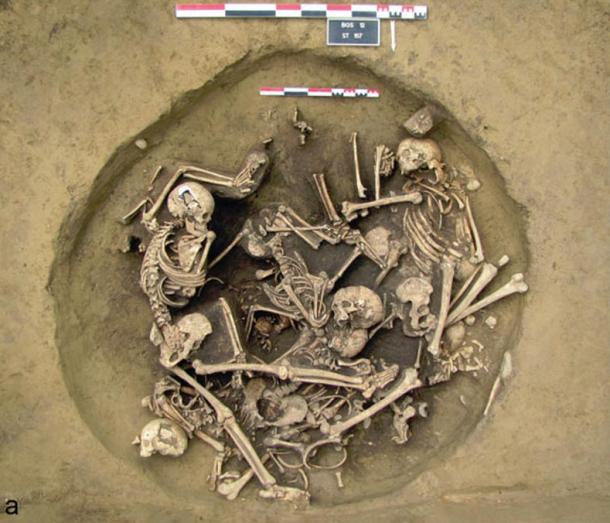Pit of Amputated arms in France from 6,000 years ago suggest war and trophy taking
6,000 years ago, a circular pit with the bodies of seven people on a bed with seven arms sheds fresh light on violent disputes. Experts claim the gruesome discovery tells the tale of a devastating raid on a settlement in eastern France that may have wiped out an entire family.
Bloodthirsty attackers will also take arms as war trophies and tortured the victims before burying their bodies.
The 6.5ft (two metres) deep circular pit was found in Bergheim by archaeologists from Antea Archéologie in Habsheim and the universities of Strasbourg and Bordeaux.

It contains seven human skeletons and part of a child’s skull on top of the remains of seven amputated human arms. The find, dubbed Pit 157, measures almost 5ft (1.5 metres) in diameter at the base and 6.2ft (1.9 metres) in diameter at its top.
The experts believe two men, one woman and four children were killed in a raid or some sort of violent encounter. Their bodies were thrown in the pit on top of a pile of left arms, thought to have been fractured then hacked off using hand axes.
Scattered hand bones on the bottom layer suggest hands from severed limbs were chopped into pieces. Study author Fanny Chenal of Inrap told Gizmodo: ‘For a long time, Neolithic societies were considered relatively egalitarian and peaceful.
‘But for several years a lot of research has shown that it was not the case.’
In fact, she thinks the war was common in Neolithic times and while there is no clear evidence of this in France, there is evidence in Germany from the same time. It is not clear to whom the arms belong, since the skeletons on top of them have both their arms, apart from the remains of one male.
As well as missing his arm, which may or may not be in the pit, his skull shows signs of violence that likely resulted in his death. The researchers are unsure whether the burial suggests some sort of macabre post-battle ritual.


They are also unsure why the attackers targeted people’s left arms, however, they hypothesise the limbs may have been hacked off as war trophies. Dr Chanal said the arms were buried with the remains but think they are from the same social group.
‘Pit 157 represents clear evidence of what was probably an act of inter-group armed violence, that is to say, “war,” although the true nature of these practices remains difficult to understand,’ explained the study.
Carbon dating shows the bones are between 5,500 and 6,000 years old. At this time, it was common for bodies to be buried in circular pits among farming communities across central and Western Europe.
But the unusual Bergheim grave is the first evidence that those butchered in raids were buried in the same way. Dr Chenal added: ‘It’s a very important result, but it raises more questions than it answers.’
There is already debate about whether such circular pits were remnants of storage pits and repurposed for people not deemed worthy of a grander burial, or were used for high-ranking people.


Some pits containing the remains of several people suggest slaves or relatives were killed to be buried with an important person, and there are even theories saying circular pits were used for human sacrifices.
But the study explained: ‘The evidence from pit 157 undoubtedly testifies to armed violence, and the amputated arms, most probably trophies, are suggestive of an act of war.
‘The presence of women and children in the pit does not go against this hypothesis: They may have been victims of raids, killed on the scene of the confrontation or captured and executed afterwards – although women and children were often enslaved, they were also sometimes tortured and killed.
‘Whether they were victims of warfare or the recipients of judicial punishment, the case supports the idea that the haphazardly deposited individuals were either dependants or excluded individuals.’
Of the 60 pits uncovered in Bergheim, 14 contained human bones and only one, described in the study published in the journal Antiquity, showed signs of violence or limb loss. It is possible the victims were either tortured, or their limbs were amputated after death to intimidate the living or offend the dead – a practice documented in Florida in the 16th century, which seems to echo that of the Bergheim burial.
‘The evidence from this site challenges the simplicity of existing interpretations, and demands a more critical focus on the archaeological evidence for acts of systematic violence during this period,’ the study concluded.


